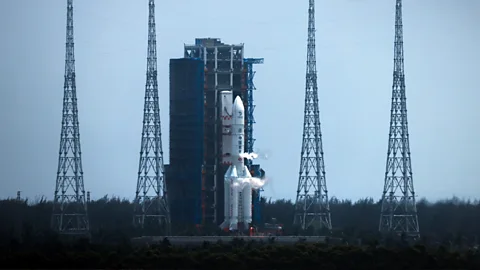BusinessInternational News
Chang’e-6 is just the tip of China’s ambitions for the Solar System
Chang'e-6 is just the tip of China's ambitions for the Solar System


China’s Chang’e-6 mission is intended to bring back lunar samples but is also a stepping stone to much more ambitious space exploration.
China launched one of its most ambitious missions so far on 3 May, sending a stack of four spacecraft towards the Moon.
The aim is to collect the first samples from the lunar far side and deliver them safely to Earth, potentially bringing back new insights into our nearest neighbour, our own planet, and the early history of the Solar System. To do this, the quartet will need to perform an intricate cosmic dance.
The Chang’e-6 spacecraft spent roughly 4.5-days on its voyage to the Moon. Once in orbit around the Moon, a lander separated from the orbiter and targeted a landing area within Apollo crater on the far side of the satellite, where it is expected to land in early June. As this far side of the Moon never faces Earth, operations and communications with Earth will be facilitated by Queqiao-2, a communications relay satellite launched by China in March.
The lander will use a scoop and a drill to collect surface and subsurface materials. These will be blasted into lunar orbit by an ascender, which will then be tasked with catching up with the orbiter and handing over its precious cargo.
A precise rendezvous and docking between orbiter and ascender will need to be affected while travelling at just over a mile per second (1.68km per second). This will need to be automated, due to the light-time delay due to their distance from ground stations on Earth.
After this celestial game of cat and mouse, the samples will be transferred to a reentry capsule. That spacecraft – resembling a mini version of the return module of China’s Shenzhou crew spacecraft – will be released just before the orbiter reaches Earth. It will first bounce itself off Earth’s atmosphere to help shed some of the energy from its high-speed return from the Moon, then plummet through the atmosphere to deliver the samples to a landing area in the grasslands of Inner Mongolia.
 Getty Images
Getty ImagesGetting these samples, taken from a vast impact crater known as South Pole-Aitken (SPA) Basin, to laboratories could bring a diversity of invaluable science payoffs.
“The SPA basin is one of the best places to go on the Moon to get rocks which can be investigated to answer questions we have about the Moon’s origins and geological evolution,” says Katherine Joy, professor of lunar and planetary science at the University of Manchester in the UK. The rocks collected by Chang’e-6 will notably be the first from the lunar farside, while the Apollo missions all visited the nearside. “Hopefully these will help us unlock why the near and far side of the Moon are so geologically different from each other.”
“The samples collected will also help us date the huge impact basin itself, shedding light on when huge planetary embryos were striking the Moon in its early history,” Joy says.
Aside from the scientific intrigue however, the Chang’e-6 mission also belies some of China’s even grander ambitions.
These manoeuvres will be useful practice for another possible mission: grabbing samples from Mars. While lunar samples promise big science returns in terms of Solar System secrets, Red Planet material could, potentially, provide new insights into the greatest mystery: the origins of life and whether or not Mars is habitable.
SOURCE: BBC




